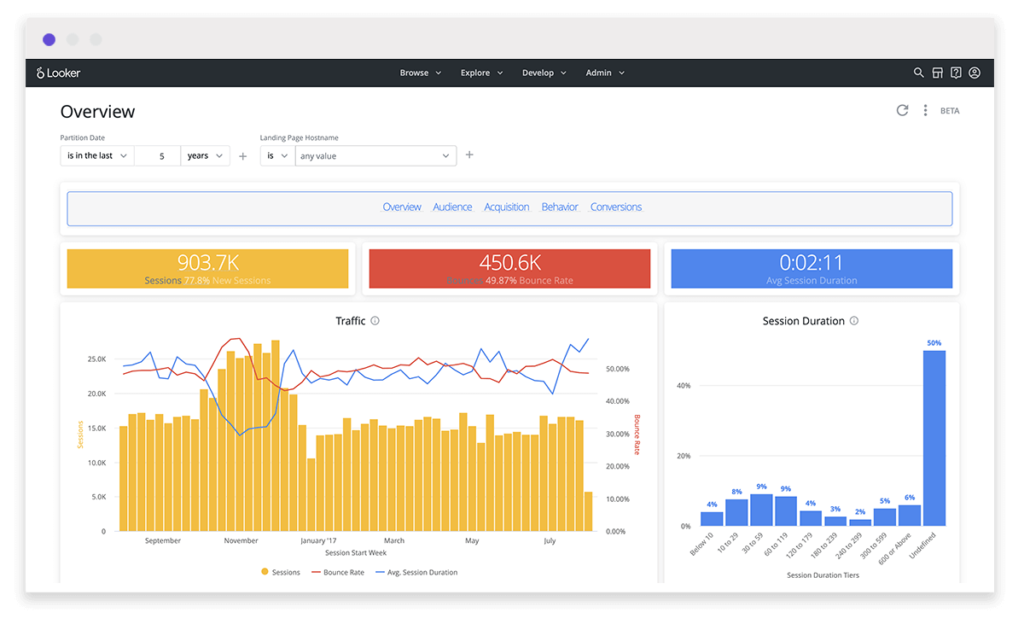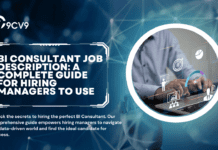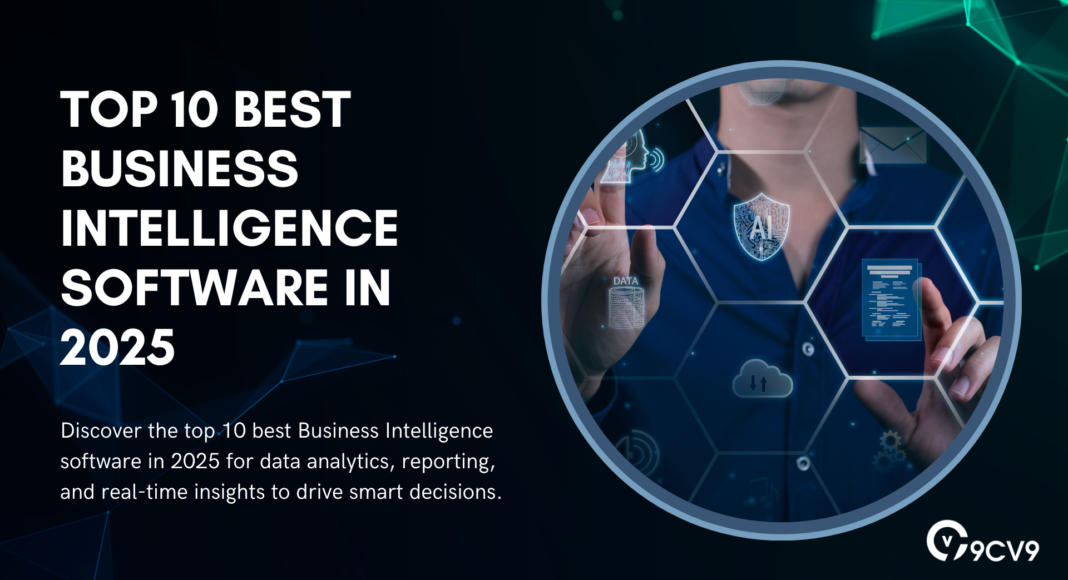Key Takeaways
- Discover the leading Business Intelligence software in 2025, designed to empower data-driven decision-making and real-time analytics.
- These tools offer advanced reporting, seamless integrations, and user-friendly interfaces for businesses of all sizes.
- Stay ahead of the competition with scalable solutions that provide actionable insights, predictive analytics, and enhanced data governance.
In 2025, the business world is increasingly relying on data-driven decision-making to stay competitive and achieve long-term success.
Business Intelligence (BI) software plays a critical role in this transformation, empowering companies to analyze vast amounts of data, uncover actionable insights, and optimize their strategies in real time.
With the exponential growth of data across industries, choosing the right BI tool has never been more crucial.
From small businesses to large enterprises, organizations are recognizing the need for robust solutions that provide comprehensive data analytics, reporting, and visualization capabilities.

As the demand for more efficient and intelligent decision-making continues to grow, the BI software landscape has evolved significantly.
Today’s top BI tools offer advanced features such as artificial intelligence (AI) integration, machine learning (ML) algorithms, natural language processing (NLP), and predictive analytics, making it easier than ever to turn raw data into meaningful insights.
These tools not only help businesses uncover trends and patterns but also enable them to forecast future performance, detect potential risks, and streamline operations.
Selecting the right BI software is a strategic decision that impacts every department—from marketing and sales to finance and operations.
The right BI platform can enhance productivity, improve collaboration, and ensure that business leaders have access to accurate, real-time information.
In this fast-paced digital landscape, businesses must remain agile, and BI software offers the tools necessary to navigate this complexity and stay ahead of the curve.
In this comprehensive guide, we’ll explore the top 10 business intelligence software tools in 2025.
We will review their features, capabilities, pricing models, and more to help you identify the ideal solution for your organization.
Whether you are a small startup looking for an affordable yet powerful tool, or a large enterprise seeking an advanced, scalable BI solution, this guide will provide all the information you need to make an informed decision.
Discover how the best BI software in 2025 can drive growth, foster innovation, and ensure data-driven success for your business.
Before we venture further into this article, we would like to share who we are and what we do.
About 9cv9
9cv9 is a business tech startup based in Singapore and Asia, with a strong presence all over the world.
With over nine years of startup and business experience, and being highly involved in connecting with thousands of companies and startups, the 9cv9 team has listed some important learning points in this overview of the Top 10 Best Business Intelligence Software in 2025.
If your company needs recruitment and headhunting services to hire top-quality employees, you can use 9cv9 headhunting and recruitment services to hire top talents and candidates. Find out more here, or send over an email to [email protected].
Or just post 1 free job posting here at 9cv9 Hiring Portal in under 10 minutes.
Top 10 Best Business Intelligence Software in 2025
- Microsoft’s Power BI
- Tableau
- Qlik
- Sisense
- Domo
- Zoho Analytics
- Looker
- IBM Cognos Analytics
- MicroStrategy
- SAP BusinessObjects
1. Microsoft’s Power BI

Microsoft Power BI is widely regarded as one of the top business intelligence (BI) software solutions in 2025 due to its exceptional capabilities in data integration, visualization, and real-time analytics. A standout feature of Power BI is its seamless integration with the entire Microsoft ecosystem, including tools like Excel and Azure, making it particularly beneficial for businesses that are already leveraging Microsoft products. This platform excels in providing a comprehensive set of tools that allow businesses to prepare, analyze, and visualize data effortlessly.
As a cloud-based solution, Power BI ensures that businesses can access their data from anywhere, offering unmatched flexibility. The platform automatically updates data in real-time, enabling organizations to make informed decisions based on the most current information. This feature is particularly valuable for businesses that need to monitor key performance indicators (KPIs) and track trends as they unfold, ensuring that decisions are data-driven and timely.
One of the key reasons Power BI is highly regarded is its powerful data visualization features. The platform offers a wide variety of interactive visualizations, enabling users to create detailed and intuitive reports and dashboards that not only convey insights clearly but also allow for interactive exploration of the data. This empowers businesses to uncover deeper insights and make more informed decisions. The visualizations can be shared across teams, fostering collaboration and driving alignment within the organization.
Furthermore, Power BI distinguishes itself with its AI-powered analytics. The platform integrates advanced machine learning capabilities, helping businesses uncover hidden patterns and trends in their data that might otherwise go unnoticed. AI-driven insights enable organizations to predict future outcomes, making it an indispensable tool for businesses seeking to stay ahead of market trends and make proactive decisions. Additionally, Power BI supports real-time data streaming, which is critical for businesses that need to respond quickly to changing conditions.
Power BI’s integration with Microsoft Fabric enhances its ability to provide AI-driven insights. This integration helps businesses to easily analyze large datasets and generate actionable insights, ensuring that companies can derive maximum value from their data. For businesses with complex data needs, Power BI’s robust data security features are another notable advantage. The platform offers sensitivity labeling and integrates with Microsoft Cloud App Security to ensure that sensitive data is protected and compliant with industry standards.
In terms of connectivity, Power BI supports a wide range of data sources, including databases, spreadsheets, cloud services, and even social media platforms. This extensive connectivity ensures that businesses can consolidate all of their data into a single platform, streamlining the data analysis process. Additionally, Power BI’s ability to embed its reports and dashboards into custom applications via Power BI Embedded makes it a versatile tool for businesses looking to integrate data insights directly into their operational workflows.
Another standout feature of Power BI is its collaborative capabilities. Users can easily share reports and dashboards across a variety of platforms, including Microsoft Teams, PowerPoint, and Excel, ensuring that insights are accessible to all stakeholders. This feature is especially valuable for organizations with distributed teams, as it allows for seamless collaboration regardless of location.
Microsoft Power BI’s continuous evolution and commitment to meeting the growing demands of modern businesses make it a top choice in 2025. With its comprehensive suite of tools for data visualization, advanced analytics, AI-powered insights, real-time updates, and robust security features, Power BI remains a powerhouse in the business intelligence space, offering unmatched value to businesses of all sizes. Whether you are a small business seeking an affordable solution or a large enterprise requiring an enterprise-grade platform, Power BI provides the versatility and scalability necessary to meet diverse data analysis needs.
2. Tableau

Tableau stands out as one of the most prominent and user-centric business intelligence (BI) tools of 2025, earning its reputation for providing an intuitive, highly accessible platform that simplifies complex data analysis. Known for its powerful data visualization capabilities, Tableau enables users to transform vast and intricate datasets into interactive, visually appealing dashboards with ease. The platform’s drag-and-drop interface allows both seasoned analysts and beginners to manipulate and present data without the need for complex coding or technical expertise, making it one of the most user-friendly BI solutions available.
A key feature that elevates Tableau in the competitive BI landscape is its seamless integration with a wide variety of data sources, including databases like Oracle, SQL Server, and MySQL, as well as cloud platforms and spreadsheets. This robust data connectivity ensures that users can access and analyze data from multiple systems in one cohesive platform. Tableau also boasts advanced data exploration capabilities, allowing businesses to gain deeper insights from their datasets. With the ability to quickly blend data from disparate sources, Tableau delivers a comprehensive view of business performance, enabling organizations to make more informed decisions.
Tableau’s advanced analytics tools are a standout feature, equipping businesses with predictive modeling, forecasting, and trend analysis. These capabilities allow organizations to not only understand historical data but also anticipate future outcomes with remarkable accuracy. This makes Tableau an invaluable tool for companies seeking to stay ahead of industry trends and market shifts. Its AI-powered functionalities, including natural language querying and machine learning integrations, further enhance its analytical capabilities, making it easier for users to gain insights without requiring advanced knowledge of programming languages like Python or R.
The platform’s real-time analysis features are another powerful advantage. Tableau allows users to track live data streams, providing instant insights and enabling businesses to respond swiftly to emerging trends or issues. This feature is especially critical for companies operating in fast-paced industries where timely decision-making is essential. Tableau’s ability to update and refresh data in real-time ensures that business leaders always have access to the most up-to-date information, allowing them to make well-informed decisions on the fly.
Tableau’s customizable dashboards and reports are an additional highlight. Users can tailor their visualizations with interactive filters, parameters, and calculations, making the platform incredibly flexible and adaptable to various business needs. The ability to share these dynamic dashboards and reports across teams or organizations fosters greater collaboration, allowing stakeholders to access, analyze, and discuss data-driven insights in real-time, no matter their location.
Another powerful aspect of Tableau is its mobile accessibility. Users can access their dashboards and visualizations from any device, ensuring that data analysis and decision-making are not confined to a desktop. This mobile functionality is particularly valuable for businesses with remote or distributed teams, as it ensures that everyone has access to critical data and insights at all times.
With a strong focus on user experience, Tableau provides an active community and a wealth of support resources, ensuring that users can quickly resolve issues and fully harness the potential of the platform. The platform’s ease of use, combined with its sophisticated data exploration, real-time analytics, and AI-driven capabilities, makes it an ideal choice for businesses looking to elevate their business intelligence capabilities in 2025.
Tableau’s wide array of features, including interactive dashboards, real-time data updates, predictive analytics, and customizable reporting, make it one of the leading BI software solutions of 2025. Whether it’s analyzing historical trends or predicting future developments, Tableau offers businesses the tools they need to make data-driven decisions with confidence. With its user-friendly interface, comprehensive data connectivity, and robust analytical features, Tableau continues to be a frontrunner in the BI space, offering immense value to organizations of all sizes.
3. Qlik

Qlik stands as a powerful and versatile business intelligence (BI) software solution, well-regarded for its emphasis on self-service analytics and its ability to provide intuitive insights to users at all levels. With its user-friendly design, Qlik empowers both novice users and seasoned professionals to harness the power of data, offering customizable dashboards, interactive visualizations, and advanced AI-driven analytics. Its strong cloud capabilities, cutting-edge artificial intelligence features, and ability to cater to diverse analytics use cases make Qlik a standout choice in 2025 for businesses looking to gain actionable insights and drive data-driven decision-making.
A key reason Qlik is recognized as one of the top BI software tools in 2025 is its sophisticated yet accessible analytics features. The platform leverages AI-powered data models to generate insights, helping organizations uncover patterns and trends that may otherwise remain hidden. Qlik’s powerful self-service capabilities allow users to create their own dashboards, reports, and visualizations, providing businesses with the flexibility to adapt and grow their BI processes as their needs evolve. This self-service model is particularly beneficial for organizations that want to empower their teams to explore data independently and make decisions without relying on specialized technical resources.
Qlik’s robust data ingestion and integration features make it a comprehensive solution for organizations looking to centralize their analytics processes. The Connector Factory, an extensive marketplace offering more than 150 connectors, simplifies the process of integrating various data sources into the platform. This flexibility is essential for businesses that utilize multiple platforms and applications, as Qlik enables seamless data integration from a wide variety of systems, enhancing the scope and depth of analytics efforts.
Another standout feature of Qlik is its highly advanced dashboarding capabilities. With over a hundred pre-built dashboard templates, Qlik helps businesses visualize key metrics and KPIs with ease, offering a streamlined way to monitor performance and track business outcomes. These templates can be customized to suit the unique needs of an organization, ensuring that teams can share insights quickly and efficiently.
Qlik Sense, the core component of Qlik’s BI platform, is particularly recognized for its powerful associative data engine, which enables users to perform in-depth data exploration and uncover valuable insights. By offering a conversational interface, Qlik fosters greater engagement and accessibility for users, encouraging data discovery through simple queries. This makes it an ideal tool for businesses with varying levels of data literacy, as newcomers can easily engage with the platform, learning about data analysis and building their expertise as they go.
One of Qlik’s most notable unique selling points is its support for augmented and predictive analytics. Using AI and machine learning algorithms, the software provides users with actionable insights, forecasts, and trends that can guide decision-making. By blending historical and real-time data, Qlik helps companies not only understand past performance but also make informed predictions about future outcomes, a critical advantage for businesses that need to stay agile and competitive.
Qlik’s reporting capabilities are equally impressive, with features that allow for both scheduled and ad-hoc reports, ensuring that key insights are always delivered on time. Reports can be sent via email, shared folders, or centralized platforms, making it easy for teams to stay updated on critical data and trends. This flexibility in reporting helps businesses streamline their workflows and ensures that stakeholders have access to the right information when they need it.
The collaboration features offered by Qlik further enhance its value as a top BI solution. Through discussion threads, users can interact and collaborate around specific data points, fostering a collaborative environment where ideas and insights can be shared easily. Additionally, Qlik’s mobile BI capabilities allow teams to access dashboards and insights on any device, ensuring that critical data is always at hand, no matter where users are.
As businesses continue to rely on data for competitive advantage, Qlik’s ability to integrate embedded BI features into third-party applications, products, and services makes it an even more valuable asset. This integration ensures that Qlik’s capabilities can be extended across various touchpoints within an organization, creating a seamless flow of insights across business processes.
Qlik’s combination of AI-powered analytics, strong data integration, customizable reporting, and self-service capabilities makes it an essential tool for businesses aiming to unlock the full potential of their data. Whether a small startup or a large enterprise, Qlik’s scalability ensures that it can grow alongside an organization, making it one of the best business intelligence software options for 2025. By offering a range of analytics tools, from prescriptive analytics to real-time collaboration, Qlik enables businesses to make smarter, data-driven decisions, ultimately driving success and innovation across industries.
4. Sisense

Sisense continues to be one of the most powerful and innovative Business Intelligence (BI) platforms in 2025, offering advanced analytics and data visualization capabilities tailored for businesses of all sizes. What sets Sisense apart is its ability to seamlessly process vast amounts of structured and unstructured data with exceptional speed and efficiency. This is made possible by its proprietary In-Chip technology, which significantly accelerates data querying and processing without requiring costly hardware investments or extensive coding expertise. As a result, organizations can derive real-time insights from complex data sets, enabling data-driven decision-making at every level.
Why Sisense is Among the Best Business Intelligence Tools in 2025
- Revolutionary In-Chip Technology for Faster Data Processing
- Unlike traditional BI tools that rely on RAM or disk-based processing, Sisense’s In-Chip technology optimizes CPU usage to handle massive datasets efficiently.
- Businesses can analyze data at unprecedented speeds, reducing latency and enabling real-time reporting.
- Eliminates the need for expensive IT infrastructure, making it a cost-effective solution for organizations looking to scale their analytics capabilities.
- Intuitive, User-Friendly Dashboard Creation
- Sisense simplifies data visualization with a drag-and-drop interface, allowing users to create custom dashboards effortlessly.
- Non-technical users can generate dynamic reports without relying on IT teams, improving accessibility and collaboration.
- The platform offers fully customizable, interactive dashboards that provide a comprehensive overview of key business metrics.
- Advanced Analytics and AI-Driven Insights
- Sisense integrates cutting-edge AI and machine learning capabilities to facilitate predictive analytics, allowing organizations to anticipate trends and optimize strategies proactively.
- Features natural language processing (NLP) for easy data querying, enabling users to interact with data conversationally without requiring SQL knowledge.
- Built-in AI-powered forecasting tools provide actionable recommendations based on historical and real-time data.
- Scalable, Cloud-Based and Hybrid Deployment Options
- Sisense offers flexible deployment models, including cloud, on-premise, and hybrid environments, catering to diverse business needs.
- Businesses can scale analytics operations seamlessly without worrying about performance bottlenecks or infrastructure limitations.
- Its cloud-native architecture ensures seamless integration with third-party applications, including Google Analytics, Salesforce, and other major platforms.
- Self-Service BI with Embedded Analytics
- Sisense democratizes data access by enabling users across various departments to analyze and visualize data independently.
- Offers white-label analytics, allowing businesses to embed customized dashboards and reports directly into their existing platforms or client-facing applications.
- The software supports pro-code, low-code, and no-code development approaches, making it a versatile choice for both technical and non-technical users.
- Real-Time Insights for Informed Decision-Making
- Sisense empowers organizations with real-time analytics, enabling stakeholders to track performance metrics instantly.
- Users can monitor key performance indicators (KPIs) through live dashboards, ensuring they stay ahead of market changes and operational inefficiencies.
- Supports automated alerts and notifications, allowing businesses to respond proactively to emerging trends and anomalies.
- Robust Security and Data Governance
- Sisense ensures enterprise-grade data security and compliance, making it a reliable choice for industries handling sensitive information.
- Features role-based access control (RBAC) to regulate user permissions, ensuring that only authorized individuals can access specific datasets.
- Adheres to industry regulations such as GDPR, HIPAA, and SOC 2, providing businesses with peace of mind regarding data protection.
How Sisense Works: A Simplified End-to-End BI Solution
- Data Integration & Modeling
- Sisense seamlessly connects with multiple data sources, including cloud storage, databases, spreadsheets, and web applications.
- Users can blend data from disparate sources into a unified ElastiCube, Sisense’s proprietary high-performance data storage engine.
- Data Analysis & Visualization
- The platform enables users to create interactive reports and dashboards, leveraging AI-powered analytics for deeper insights.
- Built-in tools allow for easy customization of charts, graphs, and widgets to present data effectively.
- Actionable Insights & Impactful Reporting
- Sisense helps organizations turn raw data into actionable intelligence, supporting data-driven decision-making at all levels.
- Businesses can embed dashboards into external applications or share reports with internal teams for enhanced collaboration.
Conclusion
Sisense remains a game-changing BI tool in 2025, offering speed, flexibility, and scalability for businesses looking to extract maximum value from their data. Its proprietary In-Chip technology, AI-powered analytics, and self-service BI capabilities make it a standout choice among business intelligence platforms. Whether for large enterprises handling big data or small businesses seeking cost-effective analytics solutions, Sisense provides an intuitive, powerful, and secure platform for data-driven success.
5. Domo

Domo is a cutting-edge, cloud-native business intelligence (BI) platform that empowers organizations to harness the full potential of their data. As one of the most advanced BI solutions available in 2025, Domo is designed to integrate seamlessly with existing data warehouses and analytical tools, transforming raw data into meaningful insights. Its ability to centralize data from multiple sources, create real-time visualizations, and offer predictive analytics sets it apart as a game-changing tool for modern enterprises.
Unlike traditional BI tools that often require extensive technical expertise, Domo is engineered with a user-friendly interface that caters to both data experts and business users. By enabling real-time data sharing, automated reporting, and AI-powered analytics, Domo facilitates faster, smarter decision-making across all levels of an organization.
Key Features That Make Domo a Leading BI Solution
Seamless Data Integration & Connectivity
- Domo provides an extensive library of pre-built data connectors, allowing organizations to integrate with cloud-based and on-premise data sources effortlessly.
- It ensures an interconnected and error-free data ecosystem by merging disparate data into a unified platform, eliminating silos and improving consistency.
- Businesses can extract insights from structured and unstructured data, streamlining workflows and enhancing operational efficiency.
Intuitive & Interactive Data Visualization
- The platform offers dynamic and customizable dashboards that transform static charts into interactive, real-time visual representations.
- With drag-and-drop functionality, users can create visually appealing reports and dashboards without requiring advanced programming skills.
- The ability to personalize dashboards ensures that different departments—from marketing to finance—can analyze data in a format most relevant to their specific needs.
AI-Powered Insights & Predictive Analytics
- Domo integrates artificial intelligence (AI) and machine learning (ML) capabilities to help businesses uncover trends, forecast outcomes, and automate data analysis.
- Organizations can use AI-powered natural language queries to ask complex questions and receive instant, data-backed answers.
- With real-time trend analysis, businesses can adapt strategies proactively, ensuring they stay ahead of market changes.
Cloud-Native Architecture for Scalability & Performance
- Unlike traditional BI tools that rely on rigid on-premise infrastructures, Domo’s cloud-first approach offers dynamic scalability.
- The platform leverages massively parallel processing (MPP) to handle vast amounts of data with exceptional speed and accuracy.
- With its flexible cloud deployment, businesses of all sizes can scale operations efficiently without investing in costly hardware.
Enhanced Collaboration & Mobile Accessibility
- Domo enables real-time collaboration with in-context chat, task tracking, and user profiles, ensuring teams can work together on insights effortlessly.
- The mobile-friendly interface ensures that decision-makers can access, analyze, and share data from anywhere using iOS and Android applications.
- Automated alerts and scheduled content sharing ensure that stakeholders receive critical data updates without manual intervention.
Why Businesses Choose Domo in 2025
- Empowers Non-Technical Users: With its no-code and low-code analytics, Domo democratizes data access, allowing anyone in the organization to generate insights.
- Automates Business Intelligence Workflows: By leveraging AI-driven automation, Domo eliminates the need for manual reporting and enhances operational efficiency.
- Delivers Real-Time, Actionable Insights: The platform ensures businesses are always working with the latest data, enabling faster and more informed decision-making.
- Scales with Business Growth: Whether a startup or an enterprise, Domo’s cloud-native infrastructure adapts to evolving data needs without additional IT overhead.
Final Thoughts
Domo stands out as one of the top business intelligence software solutions in 2025 due to its innovative blend of cloud scalability, AI-powered analytics, intuitive data visualization, and seamless integration capabilities. By transforming raw data into actionable insights in real time, Domo helps businesses stay competitive, make data-driven decisions with confidence, and drive meaningful outcomes. With its commitment to accessibility, automation, and advanced analytics, Domo is not just a BI tool—it is a strategic asset for forward-thinking enterprises.
6. Zoho Analytics

Zoho Analytics stands out as one of the top business intelligence (BI) software solutions in 2025, offering an intuitive, cost-effective, and feature-rich platform designed to help businesses extract meaningful insights from their data. As a self-service BI tool, it enables organizations of all sizes—particularly small to mid-sized enterprises—to integrate, analyze, and visualize data with ease. By automating data synchronization, providing AI-powered insights, and supporting seamless collaboration, Zoho Analytics simplifies the data-driven decision-making process, making it an essential asset for businesses looking to gain a competitive edge.
What sets Zoho Analytics apart is its robust data integration capabilities, allowing organizations to blend and merge data from multiple sources, including cloud applications, databases, spreadsheets, and offline systems. With an interactive drag-and-drop interface, customizable dashboards, and AI-driven analytics, users can create in-depth reports without needing advanced technical expertise. Additionally, its affordability makes it an attractive option for businesses with budget constraints, offering enterprise-grade BI functionalities at a fraction of the cost.
Key Features That Make Zoho Analytics a Leading BI Tool
Effortless Data Integration & Auto-Sync Capabilities
- Zoho Analytics supports seamless data integration from a wide range of sources, including cloud storage, business applications, online and offline databases, and public datasets.
- The automatic data synchronization feature ensures real-time data updates, eliminating the need for manual imports and ensuring reports and dashboards reflect the latest insights.
- With its flexible API integrations, businesses can connect to third-party applications effortlessly, making data extraction and transformation more efficient.
AI-Powered Insights with Ask Zia
- Ask Zia, Zoho’s AI-powered analytics assistant, leverages natural language processing (NLP) and machine learning to help users generate complex queries effortlessly.
- Users can simply ask questions in plain English, and the system will return relevant insights, visualizations, and reports instantly.
- By integrating ChatGPT-powered AI, Zoho Analytics enables businesses to access public datasets and external information without switching between multiple platforms.
Intuitive Data Visualization & Interactive Dashboards
- The drag-and-drop report builder allows users to create custom dashboards and visualizations without requiring advanced coding skills.
- Users can merge and blend datasets from different sources, using lookup columns and SQL queries to identify patterns, trends, and correlations within their data.
- The interactive dashboards provide real-time, dynamic insights, allowing users to zoom into crucial metrics and drill down into granular data points.
Seamless Collaboration & Secure Data Sharing
- Zoho Analytics facilitates collaborative data analysis with its built-in commenting section, enabling teams to share insights, discuss trends, and take action collectively.
- Users can schedule and automate report sharing, ensuring that key stakeholders receive the latest insights without manual intervention.
- Advanced data governance and role-based access controls ensure that sensitive business information is securely managed, limiting access to authorized personnel only.
Why Businesses Choose Zoho Analytics in 2025
- Cost-Effective & Scalable: Unlike many BI tools that come with expensive licensing fees, Zoho Analytics offers a budget-friendly solution without compromising on powerful BI functionalities.
- User-Friendly for Non-Technical Users: With its no-code, drag-and-drop interface, even users with minimal technical expertise can generate detailed reports and interactive dashboards.
- AI & ML-Driven Analytics: The integration of AI-powered insights enhances decision-making by automating data analysis, forecasting trends, and identifying anomalies.
- Multi-Source Data Integration: Businesses can connect and analyze data from various platformseffortlessly, ensuring a holistic view of operations and performance metrics.
- Trusted by Over 100 Million Users Worldwide: With a strong global customer base, Zoho Analytics has gained the trust of leading brands and enterprises across industries.
Final Thoughts
Zoho Analytics has positioned itself as a top-tier BI solution in 2025, providing businesses with a powerful yet accessible platform for advanced data analysis, visualization, and collaboration. By leveraging AI-driven insights, real-time data synchronization, and seamless integration capabilities, Zoho Analytics enables businesses to make data-driven decisions with confidence. Whether a startup, mid-sized business, or multinational corporation, this scalable, cost-effective, and feature-rich BI tool ensures that organizations can maximize the value of their datawhile staying ahead in an increasingly competitive market.
7. Looker

As one of the top business intelligence (BI) tools in 2025, Looker has revolutionized the way organizations analyze and utilize data for strategic decision-making. With a powerful semantic modeling layer, enterprise-grade security, and seamless Google Cloud integration, Looker empowers businesses to transform raw data into meaningful insights. Designed to cater to both technical users and business professionals, its intuitive data exploration capabilities and advanced embedded analytics make it a standout choice for organizations looking to harness the full potential of their data.
Looker’s modern BI architecture is driven by LookML, a proprietary data modeling language that enables businesses to create structured, consistent, and reusable data models. Unlike traditional BI tools that require extensive SQL knowledge, LookML simplifies the process of defining metrics, calculations, and relationships, ensuring that all users across an organization access the same, reliable data in real time. This level of consistency eliminates data silos, enhances collaboration, and ensures a single source of truth for all decision-makers.
Why Looker is Among the Best Business Intelligence Software in 2025
1. Advanced Data Exploration & Intuitive Interface
- Looker provides drag-and-drop functionality, allowing users of all skill levels to navigate, filter, and explore data without needing complex coding knowledge.
- Users can generate interactive reports and visualizations in real time, enabling teams to extract actionable insights efficiently.
- Its powerful data exploration tools allow for deep-dive analysis, ensuring businesses can uncover trends, correlations, and anomalies.
2. LookML: A Game-Changer in Data Modeling
- LookML extends traditional SQL capabilities by providing a version-controlled, collaborative, and modular approach to data modeling.
- Businesses can define critical metrics such as ‘net revenue’ or ‘customer churn’ centrally, ensuring consistency across all reports and dashboards.
- It supports Git integration for version control, making it an ideal choice for data teams that require flexibility, scalability, and precision.
3. Centralized Data Access Across Multiple Sources
- Looker seamlessly connects to a wide range of data sources, including cloud-based databases, on-premise systems, third-party applications, and big data platforms.
- It provides businesses with a unified view of their data, eliminating the inefficiencies of fragmented and disconnected datasets.
- Users can merge and analyze data from different sources in real time, ensuring up-to-date and accurate reporting.
4. Embedded Analytics for a Seamless Data Experience
- Looker’s embedded analytics capabilities allow businesses to integrate interactive dashboards directly into websites, applications, and internal tools.
- This feature enables real-time data access within operational workflows, allowing teams to act on insights without switching between platforms.
- Organizations can create custom data-driven applications tailored to their specific business needs, enhancing the user experience and decision-making process.
5. Seamless Google Cloud Integration & AI-Powered Insights
- As a Google Cloud-owned platform, Looker natively integrates with services such as BigQuery, Google Cloud Storage, and AI/ML tools, enabling advanced data analytics.
- Users can leverage Google’s AI and machine learning capabilities to gain predictive insights, automate processes, and uncover hidden trends.
- The integration with Google Workspace (Sheets, Slides, and Drive) makes it easy to share and collaborate on reports across teams.
6. Collaboration & Data Governance at an Enterprise Level
- Looker enhances team collaboration by allowing users to share reports, dashboards, and data modelseffortlessly.
- Granular access controls ensure that sensitive data remains secure, with permissions assigned based on roles and responsibilities.
- Looker complies with top-tier security standards such as SOC 2 Type II, GDPR, and HIPAA, making it a trusted choice for enterprises handling sensitive data.
Key Benefits of Looker for Businesses in 2025
- Single Source of Truth: Eliminates inconsistencies by ensuring all users access and analyze the same unified data.
- Real-Time Insights: Provides up-to-the-minute data visibility, enabling businesses to make proactive decisions.
- Scalability: Supports large-scale data operations, accommodating growing businesses with expanding datasets.
- Cross-Platform Integration: Works seamlessly across various cloud platforms and analytic databases, not just Google Cloud.
- Customizable & Extendable: Offers API integrations and embedded analytics, allowing businesses to tailor BI functionalities to their needs.
- Security & Compliance: Ensures enterprise-grade encryption, role-based access controls, and regulatory compliance for organizations dealing with sensitive data.
Why Businesses Choose Looker for Their BI Needs
Looker has redefined the BI landscape by combining powerful data modeling capabilities, embedded analytics, and AI-driven insights into a single, cloud-based platform. Its intuitive interface, deep integration with Google Cloud, and flexible scalability make it an ideal choice for companies looking to centralize their analytics and empower data-driven decision-making.
With over 2,000 organizations worldwide—including industry giants like The Economist, Twilio, and Google itself—relying on Looker for real-time analytics and business intelligence, it has firmly established itself as a leading BI solution in 2025. Whether an enterprise seeking advanced data governance or a startup aiming to embed analytics into its products, Looker provides unparalleled flexibility, innovation, and security in modern BI technology.
8. IBM Cognos Analytics

IBM Cognos Analytics stands out as one of the top business intelligence (BI) platforms in 2025, offering a robust combination of AI-powered analytics, enterprise-grade reporting, and dynamic data visualization. Designed to empower businesses with advanced data-driven insights, this platform simplifies complex data analysis, enabling users to interact with datasets using natural language processing (NLP). By making business intelligence more accessible, even for non-technical users, IBM Cognos Analytics fosters data democratization across organizations.
As a product of IBM—a global leader in technology and innovation—Cognos Analytics integrates cutting-edge AI capabilities to enhance data discovery, predictive analytics, and business forecasting. It provides a comprehensive end-to-end analytics cycle, from data preparation and exploration to report generation and strategic decision-making. Whether deployed on-premise, in the cloud, or as part of IBM’s broader AI ecosystem, Cognos Analytics offers the scalability, security, and flexibility necessary to support enterprises of all sizes.
Why IBM Cognos Analytics is Among the Best BI Software in 2025
1. AI-Powered Data Exploration and Insights
- Integrated AI and machine learning (ML) algorithms automatically analyze data and highlight hidden patterns, trends, and anomalies.
- Natural Language Query (NLQ) functionality allows users to ask questions in plain English and receive instant, AI-generated insights.
- Predictive analytics and forecasting tools help businesses anticipate market shifts and optimize decision-making.
2. Advanced Data Integration & Seamless Connectivity
- Supports data integration from multiple sources, including cloud-based storage, on-premise databases, third-party applications, and enterprise systems.
- Provides an intuitive data modeling interface, enabling users to structure, clean, and transform raw datasetsfor deeper analysis.
- Integrates seamlessly with IBM Watson AI and other IBM software to enhance advanced analytics and automation.
3. Customizable Reporting & Interactive Dashboards
- Highly configurable reporting tools allow users to create, modify, and distribute in-depth reports with custom parameters.
- Dynamic dashboards provide visually rich, real-time data visualizations, enhancing decision-making across teams.
- Users can generate interactive scorecards and KPIs, enabling organizations to track business performance against strategic objectives.
4. Enterprise-Grade Data Governance & Security
- Features role-based access controls, ensuring only authorized personnel can view, modify, or share specific datasets.
- Complies with global security and regulatory standards, including SOC 2, GDPR, and HIPAA, making it a trusted BI solution for industries handling sensitive data.
- Built-in audit tracking and data lineage capabilities provide transparency and accountability in data management and governance.
5. Flexible Deployment Options & Scalability
- Businesses can choose from on-premise, cloud, or hybrid deployments, tailoring BI infrastructure to their operational needs.
- Seamless scalability allows enterprises to expand data processing capabilities as business needs evolve.
- Runs efficiently on IBM Cloud while remaining compatible with third-party cloud providers for greater flexibility.
6. Mobile Accessibility for On-the-Go Insights
- A dedicated mobile application enables users to access reports, dashboards, and alerts remotely.
- Features mobile-responsive visualizations, ensuring data is presented clearly across all devices.
- Push notifications and automated alerts keep decision-makers informed about critical business metrics in real time.
Key Features That Set IBM Cognos Analytics Apart
- What-If Analysis: Enables scenario-based planning by allowing users to manipulate variables and assess potential business outcomes.
- Scorecards & KPI Monitoring: Tracks key performance indicators (KPIs) and aligns business objectives with measurable metrics.
- Automated Data Preparation: AI-driven tools cleanse, structure, and enrich raw data, reducing manual workload for analysts.
- Collaborative BI: Facilitates team collaboration by allowing users to share reports, co-author dashboards, and schedule automated report deliveries.
- API & Third-Party Integrations: Connects seamlessly with IBM Watson, Microsoft Power BI, Salesforce, and other enterprise tools.
Benefits of IBM Cognos Analytics for Businesses
- AI-Driven Automation: Reduces manual data analysis efforts by leveraging AI for predictive insights and intelligent recommendations.
- Enterprise-Level Scalability: Suitable for small startups to multinational corporations, with the ability to handle large-scale data workloads.
- Unified Data Access: Provides a centralized platform for viewing, analyzing, and reporting on all business data sources.
- User-Friendly Interface: Designed for both technical and non-technical users, minimizing the need for specialized BI training.
- Improved Decision-Making: Delivers real-time insights that drive smarter business strategies, enhancing productivity and profitability.
Why Businesses Trust IBM Cognos Analytics for BI Needs
IBM Cognos Analytics is more than just a business intelligence tool—it is a comprehensive AI-driven analytics ecosystem that transforms raw data into strategic insights. By combining machine learning, predictive modeling, and advanced visualization tools, it enables organizations to stay ahead of market trends, optimize operations, and drive innovation.
With its deep integration into IBM’s AI and cloud ecosystem, Cognos Analytics has become a preferred choice for enterprises seeking a secure, scalable, and intelligent BI solution. As businesses continue to embrace AI-powered decision-making, Cognos Analytics remains at the forefront of data-driven transformation, making it one of the best BI platforms in 2025.
9. MicroStrategy

MicroStrategy has established itself as one of the top business intelligence (BI) software solutions in 2025, offering a robust and scalable analytics platform designed to handle complex enterprise data ecosystems. Known for its high-speed data processing, dynamic dashboarding, and AI-powered insights, MicroStrategy enables businesses to extract deep intelligence from vast datasets, facilitating data-driven decision-making at every level of an organization.
With its intuitive yet powerful interface, MicroStrategy bridges the gap between technical analysts and business users, allowing both to leverage advanced analytics, real-time reporting, and predictive modeling. It supports seamless data integration across multiple sources, including cloud storage, relational databases, big data platforms, and even spreadsheets, ensuring that organizations can unify and analyze their data efficiently.
MicroStrategy’s commitment to data governance, security, and enterprise scalability makes it a preferred BI solution for large corporations, particularly those handling highly sensitive or regulated data. With features like hyperintelligence, self-service analytics, and AI-powered automation, it equips businesses with the tools needed to uncover new opportunities, enhance operational efficiency, and gain a competitive edge.
Why MicroStrategy is a Leading Business Intelligence Software in 2025
1. Advanced Data Visualization & Interactive Dashboards
- Built-in data visualization tools allow users to create interactive charts, graphs, heat maps, and geospatial analytics, enabling in-depth exploration of datasets.
- Self-service dashboard creation empowers users to design custom dashboards, track key performance indicators (KPIs), and gain real-time insights with automated updates.
- Offers drag-and-drop functionality, ensuring that even non-technical users can build and customize dashboards without coding expertise.
2. AI-Driven Predictive & Advanced Analytics
- Machine learning (ML) and predictive analytics capabilities allow businesses to identify emerging trends, detect anomalies, and forecast future outcomes.
- Data mining functionalities provide a deeper understanding of customer behavior, market trends, and business performance.
- Features automated AI-driven recommendations, enabling faster and more accurate decision-making.
3. Comprehensive Reporting & Data Governance
- Offers highly formatted and detailed reporting, with extensive customization options for data drill-down, filtering, and comparative analysis.
- Provides real-time data lineage tracking, ensuring that businesses can maintain data integrity, accuracy, and compliance with regulatory standards.
- Includes metadata management and profiling tools, allowing for centralized data governance and security enforcement.
4. Multi-Source Data Integration for a Unified Analytics Ecosystem
- Connects to a wide range of data sources, including on-premise databases, cloud-based applications, IoT devices, big data platforms, and third-party software solutions.
- Supports automated data ingestion and transformation, eliminating manual processing and enabling seamless data unification across multiple platforms.
- Integrates with major enterprise applications such as SAP, Oracle, Microsoft Azure, Amazon Web Services (AWS), Google Cloud, and Salesforce, making it a versatile BI solution for businesses operating in diverse technology environments.
5. Mobile Business Intelligence for On-the-Go Decision-Making
- Features a fully optimized mobile BI application, allowing users to access reports, dashboards, and real-time alerts from their smartphones or tablets.
- Enables offline access, ensuring that decision-makers can view critical business insights even without an active internet connection.
- Incorporates push notifications and AI-driven alerts, ensuring executives and analysts are informed about important trends and anomalies in real time.
6. Enterprise-Grade Scalability & Security
- Designed to handle massive volumes of structured and unstructured data, making it an ideal solution for large enterprises with complex analytics needs.
- Offers role-based access control (RBAC) and multi-layered security protocols, ensuring that sensitive business data remains protected against unauthorized access.
- Complies with industry-standard data protection frameworks such as GDPR, HIPAA, and SOC 2, making it a trusted BI tool for organizations in highly regulated industries.
Key Features That Distinguish MicroStrategy from Competitors
- Hyperintelligence: Delivers AI-powered contextual insights embedded directly into business applications, emails, and web browsers, enabling users to make data-driven decisions instantly.
- Self-Service Analytics: Empowers business users to create their own reports and dashboards without requiring IT intervention, reducing dependency on data analysts.
- Data Blending Capabilities: Merges data from multiple sources into a single unified view, enhancing cross-functional analytics and reporting.
- Collaboration & Sharing Tools: Enables real-time data sharing, allowing teams to collaborate seamlessly across departments and geographical locations.
- Custom AI and ML Models: Supports integration with Python and R for organizations looking to develop advanced machine learning models within their BI environment.
Business Benefits of MicroStrategy’s BI Platform
- Faster Decision-Making: With real-time data access and AI-driven insights, organizations can act swiftly on market changes, customer demands, and operational inefficiencies.
- Reduced IT Workload: The platform’s self-service capabilities minimize reliance on IT teams, allowing business users to explore and analyze data independently.
- Competitive Advantage: Offers businesses the ability to identify trends, optimize performance, and develop proactive strategies, ensuring they stay ahead in their industry.
- Cost-Effective Data Management: By consolidating data sources and automating analytics workflows, organizations can reduce operational costs and improve efficiency.
- Improved Customer Insights: Advanced analytics capabilities allow companies to understand customer behavior, preferences, and engagement patterns, driving personalized marketing strategies.
Why MicroStrategy Stands Out as a Leading BI Solution in 2025
MicroStrategy is more than just a data visualization tool—it is a comprehensive business intelligence ecosystem that integrates AI, predictive analytics, and enterprise-grade security into a single powerful platform. It enables organizations to transform raw data into actionable insights, making informed decision-making faster, smarter, and more accessible.
With its ability to scale seamlessly, connect with diverse data sources, and leverage AI for deeper analytics, MicroStrategy has earned its place as one of the best BI software solutions in 2025. Businesses seeking a highly secure, feature-rich, and future-ready analytics platform will find MicroStrategy to be an invaluable asset in their data-driven transformation journey.
10. SAP BusinessObjects

SAP BusinessObjects stands as one of the top business intelligence (BI) software solutions in 2025, delivering a powerful, feature-rich suite of analytics tools designed to help organizations transform raw data into actionable insights. With its extensive capabilities in reporting, data visualization, dashboard creation, and predictive analytics, SAP BusinessObjects enables businesses to gain real-time intelligence, streamline decision-making, and drive strategic growth.
As an enterprise-grade BI platform, SAP BusinessObjects is particularly well-suited for large corporations and data-driven enterprises seeking a scalable, secure, and customizable analytics solution. Its seamless integration with SAP HANA and SAP Business Warehouse allows for high-speed data processing, real-time analytics, and deep data exploration, empowering organizations to uncover trends, mitigate risks, and optimize operations with confidence.
By offering self-service BI capabilities, interactive dashboards, and cross-enterprise sharing functionalities, SAP BusinessObjects ensures that business users, analysts, and executives alike can access meaningful insights tailored to their roles, enhancing overall data accessibility and collaboration.
Why SAP BusinessObjects is Among the Best BI Software in 2025
1. Advanced Reporting & In-Depth Analysis for Smarter Decision-Making
- Enterprise reporting tools enable organizations to create highly detailed, customizable reports, supporting strategic planning and business intelligence initiatives.
- Ad hoc reporting capabilities allow users to conduct instant data analysis, answering critical business questions without requiring extensive IT support.
- Root cause analysis and trend forecasting help businesses understand market patterns, operational inefficiencies, and potential growth opportunities.
2. Interactive Data Visualization & Role-Based Dashboards
- Dynamic dashboard creation allows users to design interactive, role-specific BI dashboards that present key performance indicators (KPIs) and analytics tailored to decision-makers.
- Offers a comprehensive suite of visualization tools, including heat maps, charts, graphs, and geospatial analytics, making data interpretation more intuitive.
- Drag-and-drop dashboard customization enables users of varying technical expertise to build personalized reports and dashboards with ease.
3. Self-Service BI with Intuitive Data Exploration
- Provides non-technical users with self-service BI functionalities, enabling them to combine datasets, run queries, and explore business trends independently.
- AI-powered insights and automation streamline analytics workflows, ensuring that users can derive valuable insights faster and more efficiently.
- Facilitates data storytelling through visualization, allowing users to create narrative-driven reports that highlight critical business intelligence findings.
4. Seamless Enterprise Integration & Cross-Platform Compatibility
- Natively integrates with SAP HANA and SAP Business Warehouse, delivering real-time data access and lightning-fast analytics processing.
- Supports connectivity with third-party applications, including cloud services, relational databases, and big data platforms, ensuring data accessibility across various business ecosystems.
- Office integration with Microsoft Excel and PowerPoint allows users to embed analytics directly into presentations, streamlining data-driven discussions.
5. Cross-Enterprise Collaboration & Secure Data Sharing
- Features real-time collaboration tools, enabling teams to share reports, insights, and dashboards across departments and locations.
- Implements role-based access controls (RBAC) and data governance mechanisms, ensuring that sensitive information is securely managed and only accessible to authorized users.
- Supports multi-device accessibility, allowing users to access and interact with business intelligence insights from desktops, tablets, and mobile devices.
6. Large-Scale Data Processing & Real-Time Analytics
- Capable of handling massive datasets, allowing enterprises to perform large-scale data analysis and forecasting with high accuracy.
- AI-driven predictive modeling helps organizations anticipate market trends, optimize resource allocation, and improve business operations.
- Offers real-time data processing capabilities, ensuring that users receive instantaneous insights for proactive decision-making.
Key Features That Make SAP BusinessObjects a Leading BI Solution
- Comprehensive Business Intelligence Suite: Combines reporting, dashboard creation, predictive analytics, and data visualization in a single, integrated platform.
- Enterprise-Grade Security & Compliance: Features robust data governance tools, encryption mechanisms, and compliance with global regulations such as GDPR and SOC 2.
- Customizable & Scalable: Designed to adapt to business needs, supporting organizations of all sizes, from mid-market companies to global enterprises.
- Embedded Analytics & AI-Powered Insights: Provides built-in AI capabilities, allowing for automated anomaly detection, pattern recognition, and strategic forecasting.
- Cloud & On-Premise Deployment: Offers flexible deployment options, ensuring businesses can choose between cloud-based, hybrid, or on-premise BI solutions based on their operational requirements.
Business Benefits of SAP BusinessObjects for Enterprises
- Faster Decision-Making: With real-time analytics and automated reporting, businesses can make data-driven decisions with greater speed and confidence.
- Enhanced Collaboration: Teams across departments can share insights, discuss findings, and align business strategies using collaborative BI tools.
- Reduced IT Dependency: Self-service analytics empower business users to generate reports independently, minimizing reliance on IT support.
- Improved Operational Efficiency: By leveraging predictive analytics and AI-driven automation, organizations can identify inefficiencies, optimize processes, and maximize profitability.
- Competitive Advantage: The ability to analyze vast amounts of structured and unstructured data ensures that businesses stay ahead in their respective industries.
Why SAP BusinessObjects is a Top BI Software in 2025
SAP BusinessObjects is more than just a data visualization or reporting tool—it is a comprehensive business intelligence powerhouse designed to meet the demands of large-scale enterprises and data-driven organizations. By combining enterprise-grade analytics, AI-powered insights, seamless data integration, and cross-enterprise collaboration, SAP BusinessObjects empowers businesses to unlock the full potential of their data.
With its ability to scale efficiently, support real-time decision-making, and integrate seamlessly with SAP and non-SAP ecosystems, SAP BusinessObjects remains one of the best BI solutions in 2025. Organizations seeking a highly secure, feature-rich, and future-proof BI platform will find SAP BusinessObjects to be an indispensable tool for achieving business intelligence excellence.
Conclusion
As businesses continue to navigate an increasingly data-driven world, selecting the right Business Intelligence (BI) software has become a critical factor in driving success. The top BI solutions in 2025 offer a combination of advanced analytics, real-time insights, powerful data visualization, and AI-driven automation, enabling organizations to transform raw data into actionable intelligence.
From scalable enterprise platforms to self-service BI tools, each software on this list caters to different business needs—whether it’s streamlining decision-making, optimizing operations, enhancing collaboration, or forecasting market trends. These solutions provide organizations with the flexibility, security, and analytical power required to stay ahead of the competition in an evolving digital landscape.
How Business Intelligence Software is Transforming Enterprises in 2025
The modern BI landscape has shifted dramatically, with organizations demanding faster, smarter, and more intuitive analytics platforms. The best BI software solutions in 2025 are designed to meet these challenges by offering:
- AI-Driven Analytics & Predictive Insights
- Artificial intelligence and machine learning capabilities help businesses identify patterns, detect anomalies, and forecast future trends with greater accuracy.
- Predictive modeling enables organizations to proactively mitigate risks, seize opportunities, and drive innovation.
- Real-Time Data Processing & Decision-Making
- Organizations no longer have to rely on outdated reports—real-time analytics empower decision-makerswith instant insights.
- The ability to analyze live streaming data ensures faster response times and improved business agility.
- Self-Service BI & User-Friendly Dashboards
- Modern BI tools emphasize ease of use, enabling business users—without technical expertise—to build reports, analyze data, and visualize key metrics independently.
- Drag-and-drop interfaces, natural language queries, and customizable dashboards make it easier for teams to interact with data.
- Scalability & Multi-Source Data Integration
- The best BI platforms in 2025 are designed to handle large-scale data processing, making them ideal for enterprises dealing with complex and high-volume datasets.
- Seamless integration with cloud-based services, on-premise databases, third-party applications, and big data platforms ensures a unified view of business intelligence.
- Enterprise-Grade Security & Compliance
- Data governance, access controls, and encryption mechanisms ensure that sensitive business information remains secure and compliant with global regulations (such as GDPR and SOC 2).
- Role-based permissions allow organizations to control who can access, modify, and share critical insights.
Which Business Intelligence Software is Right for Your Organization?
Selecting the right BI tool depends on multiple factors, including:
- Business Size & Industry
- Large enterprises may require comprehensive, scalable BI solutions like SAP BusinessObjects or MicroStrategy, which offer enterprise-wide analytics and AI-powered insights.
- Small and mid-sized businesses may benefit from self-service BI tools like Tableau or Power BI, which provide intuitive, cost-effective solutions for data visualization and reporting.
- Data Complexity & Integration Needs
- Organizations with multi-source, high-volume datasets may prefer platforms like Qlik Sense, Looker, or Sisense, which specialize in big data analytics and seamless data integration.
- Businesses relying on cloud ecosystems may find solutions like Google Looker or Zoho Analytics more suitable.
- User Accessibility & Technical Expertise
- Non-technical users might benefit from drag-and-drop dashboards and no-code BI features, making tools like Power BI, Tableau, and Google Looker ideal choices.
- Enterprises with dedicated IT teams may opt for more advanced BI platforms that offer greater customization, complex data modeling, and predictive analytics.
- Budget & Deployment Preferences
- Some BI tools offer flexible pricing models, including free, subscription-based, and enterprise licensing options.
- Organizations must also consider whether they require cloud-based, hybrid, or on-premise BI deployments.
The Future of Business Intelligence Software Beyond 2025
Looking ahead, BI software will continue to evolve, incorporating even more advanced AI, automation, and real-time analytics. Key trends shaping the future of business intelligence include:
- AI-Powered Decision Intelligence: BI tools will become even more proactive, offering automated recommendations and decision-making support.
- Augmented Analytics & Natural Language Processing (NLP): Users will interact with BI platforms using conversational AI and voice-based queries, making data exploration more intuitive.
- Deeper Cloud & Edge Computing Integration: BI solutions will enhance cloud-native analytics and edge computing capabilities, providing insights directly at the source of data generation.
- Hyper-Personalization & Embedded Analytics: BI dashboards will become more adaptive, personalized, and seamlessly embedded into daily business applications.
Final Thoughts: Why Investing in BI Software is Essential in 2025
In an era where data-driven decision-making is a competitive advantage, investing in the right Business Intelligence software is no longer optional—it is essential. The best BI tools of 2025 empower organizations with:
Faster and smarter decision-making through real-time insights and AI-driven analytics.
Enhanced productivity and collaboration with role-based dashboards and self-service BI features.
Scalability and flexibility to support businesses of all sizes, from startups to multinational enterprises.
Stronger security and governance to protect sensitive data and ensure compliance with regulations.
As businesses continue to harness the power of data, choosing the right BI solution tailored to their needs will define their future growth, operational efficiency, and competitive success. Whether you are looking for an enterprise-grade BI platform, a cloud-based analytics tool, or a user-friendly self-service solution, the top Business Intelligence software in 2025 will help you unlock the full potential of your data and drive smarter business outcomes.
If you find this article useful, why not share it with your hiring manager and C-level suite friends and also leave a nice comment below?
We, at the 9cv9 Research Team, strive to bring the latest and most meaningful data, guides, and statistics to your doorstep.
To get access to top-quality guides, click over to 9cv9 Blog.
People Also Ask
What is Business Intelligence Software?
Business Intelligence (BI) software helps organizations analyze and visualize data to make informed decisions. It transforms raw data into actionable insights using tools for reporting, analytics, and data visualization.
Why is Business Intelligence important for businesses?
BI helps businesses make data-driven decisions, improve operational efficiency, and identify opportunities. It enables leaders to visualize trends, monitor key performance indicators (KPIs), and gain insights from data in real time.
What are the top features of Business Intelligence Software?
Key features of BI software include data visualization, reporting, predictive analytics, real-time data access, self-service tools, dashboard creation, data governance, and integration with various data sources.
What makes Business Intelligence Software effective in 2025?
In 2025, effective BI software will focus on AI-powered analytics, real-time reporting, intuitive interfaces, cloud-based solutions, and seamless integration with multiple data sources to enable smarter business decisions.
How does AI enhance Business Intelligence Software?
AI in BI software improves data analysis by uncovering hidden patterns, automating data insights, providing predictive analytics, and enabling smarter decision-making with minimal human intervention.
What are the key benefits of Business Intelligence Software?
Benefits include improved decision-making, streamlined operations, enhanced data analysis, real-time insights, and the ability to identify trends and optimize strategies.
What industries benefit most from Business Intelligence Software?
Industries like retail, finance, healthcare, manufacturing, and marketing benefit the most, as they rely on data-driven decisions, trend analysis, and real-time insights to stay competitive.
How do I choose the best Business Intelligence Software for my business?
Consider factors like your business’s size, data complexity, integration needs, budget, ease of use, and scalability. Look for software with robust reporting tools, data governance, and AI capabilities to match your requirements.
Is Business Intelligence Software expensive?
The cost varies based on features, deployment options, and user needs. Cloud-based solutions often provide more affordable options with flexible pricing models, while enterprise-grade BI tools can be more costly due to advanced capabilities.
Can Business Intelligence Software be used by small businesses?
Yes, many BI tools are designed with small businesses in mind, offering user-friendly interfaces, affordable pricing plans, and scalable features that grow with your business.
What is self-service Business Intelligence Software?
Self-service BI allows users to analyze data, create reports, and build dashboards without the need for IT support. It provides non-technical users with intuitive tools for gaining insights and making data-driven decisions.
How can Business Intelligence Software improve decision-making?
BI software helps businesses make informed decisions by providing real-time data, actionable insights, predictive analytics, and visualizations, enabling decision-makers to base their actions on facts rather than intuition.
What is the difference between BI and Data Analytics?
BI focuses on analyzing historical data to inform decisions, while data analytics is more advanced, using tools like predictive modeling and AI to forecast future trends and optimize operations.
What are some popular Business Intelligence Software in 2025?
Popular BI software in 2025 includes Tableau, Power BI, Qlik Sense, Domo, IBM Cognos, MicroStrategy, SAP BusinessObjects, Sisense, and Zoho Analytics.
What is the role of data visualization in Business Intelligence?
Data visualization in BI helps convert complex data into easily understandable charts, graphs, and dashboards, enabling decision-makers to spot trends, patterns, and outliers quickly.
Can Business Intelligence Software integrate with other tools?
Yes, most BI software offers integrations with other business tools, such as CRM systems, ERP software, cloud storage services, and marketing platforms, allowing for seamless data flow and analysis.
What is predictive analytics in Business Intelligence Software?
Predictive analytics uses historical data, machine learning, and statistical algorithms to forecast future trends, helping businesses make proactive decisions and stay ahead of market changes.
How does Business Intelligence Software help with data governance?
BI software enforces data governance by providing tools for managing data access, ensuring data quality, and maintaining compliance with industry regulations through role-based permissions and data lineage.
Can Business Intelligence Software be used for real-time analytics?
Yes, many BI tools offer real-time analytics, enabling businesses to monitor and analyze live data streams, make immediate decisions, and respond to business conditions as they evolve.
What are the deployment options for Business Intelligence Software?
BI software can be deployed on-premises, in the cloud, or in hybrid environments. Cloud-based BI is increasingly popular for its scalability, cost-effectiveness, and remote accessibility.
How secure is Business Intelligence Software?
BI software prioritizes security with features such as encryption, role-based access, multi-factor authentication, and regular updates to ensure the safety and privacy of business data.
What are the benefits of cloud-based Business Intelligence Software?
Cloud-based BI offers flexibility, lower upfront costs, automatic updates, scalability, and the ability to access insights from anywhere, making it ideal for businesses of all sizes.
How does Business Intelligence Software help with performance management?
BI software helps track key performance indicators (KPIs), set goals, and monitor business performance in real time, making it easier for managers to identify areas for improvement and optimize strategies.
What is the importance of mobile access in Business Intelligence Software?
Mobile access enables decision-makers to monitor key metrics, view reports, and receive real-time updates on the go, ensuring they can make informed decisions anytime, anywhere.
What is the future of Business Intelligence Software in 2025?
The future of BI will be shaped by advancements in AI, machine learning, and cloud computing, with more emphasis on predictive analytics, real-time insights, and self-service tools that empower users at all levels.
Can Business Intelligence Software be used for financial analysis?
Yes, BI software is commonly used for financial analysis, helping businesses track expenses, revenue, cash flow, and profitability, while also providing insights into financial forecasting and budgeting.
What is the role of AI in data mining with Business Intelligence Software?
AI enhances data mining by automating the discovery of patterns, relationships, and trends within large datasets, enabling businesses to identify insights that may be difficult to spot manually.
How customizable is Business Intelligence Software?
Most BI software offers a high degree of customization, allowing users to tailor reports, dashboards, and visualizations according to their specific business needs and user preferences.
What is a data warehouse in Business Intelligence Software?
A data warehouse is a centralized repository where large volumes of data are stored and structured for easy access and analysis, allowing BI software to provide deep insights from various data sources.
How does Business Intelligence Software support strategic planning?
BI software helps businesses with strategic planning by providing insights into market trends, customer behavior, performance metrics, and forecasting, enabling companies to align their goals with data-backed strategies.
What is the difference between Business Intelligence Software and traditional reporting tools?
BI software goes beyond traditional reporting by offering interactive dashboards, predictive analytics, data visualization, and real-time insights, enabling users to make data-driven decisions more efficiently.
How does Business Intelligence Software help in marketing?
BI software assists marketing teams by analyzing customer behavior, campaign performance, ROI, and market trends, helping marketers refine strategies, target audiences, and optimize marketing spend.
Can Business Intelligence Software help with supply chain management?
Yes, BI software enhances supply chain management by providing real-time insights into inventory, demand forecasting, vendor performance, and logistics, helping businesses streamline their operations.
How does Business Intelligence Software help in customer segmentation?
BI software enables businesses to segment customers based on demographics, behavior, preferences, and purchasing patterns, helping businesses tailor marketing efforts and improve customer engagement.
What is the best Business Intelligence Software for small businesses?
For small businesses, tools like Power BI, Zoho Analytics, and Google Data Studio offer affordable, user-friendly BI solutions with essential features like data visualization, reporting, and real-time insights.































![Writing A Good CV [6 Tips To Improve Your CV] 6 Tips To Improve Your CV](https://blog.9cv9.com/wp-content/uploads/2020/06/2020-06-02-2-100x70.png)


